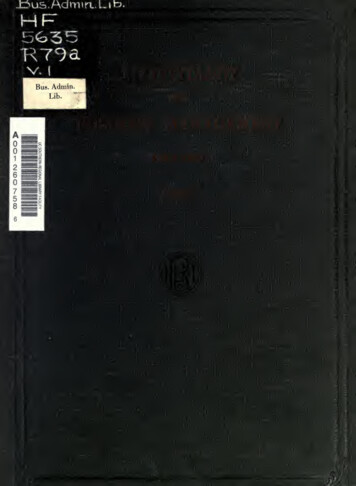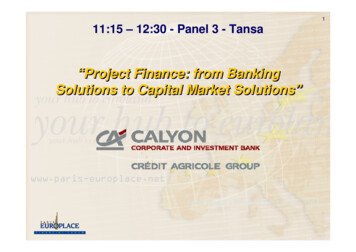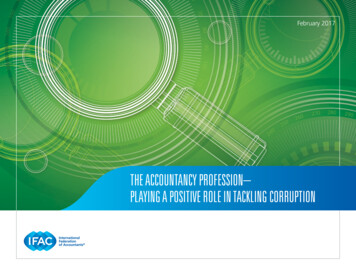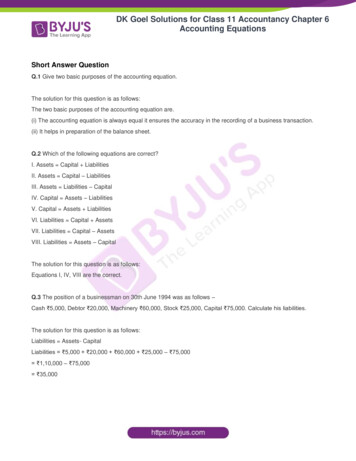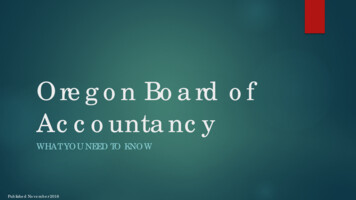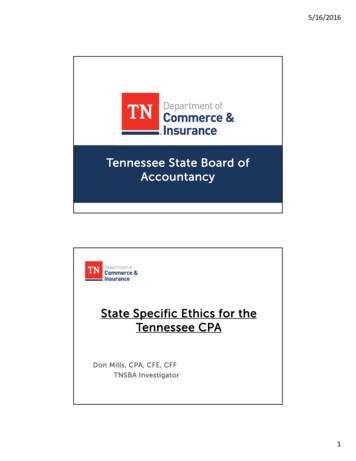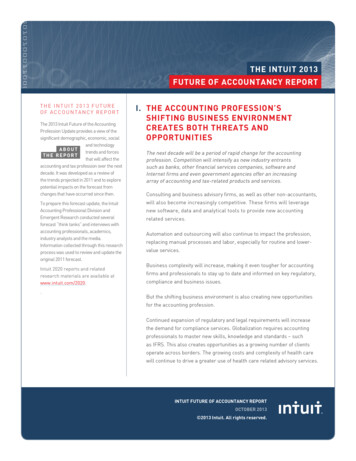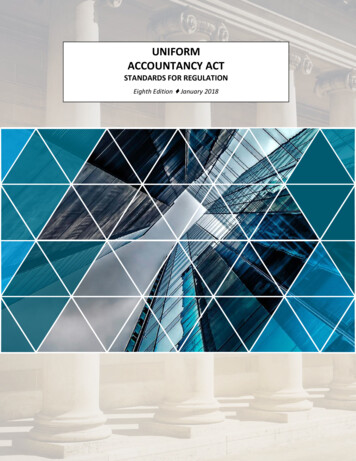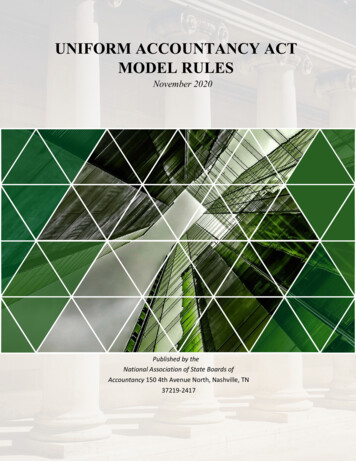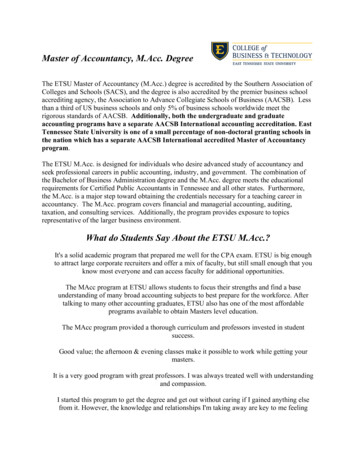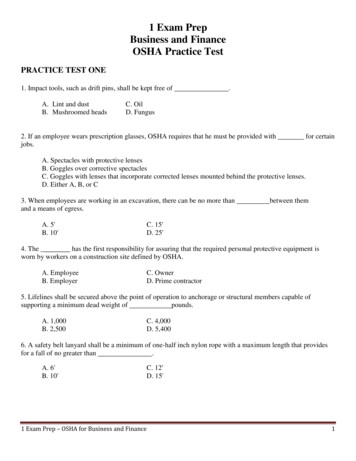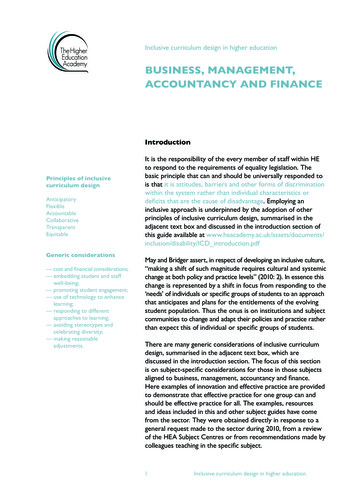
Transcription
Inclusive curriculum design in higher educationBUSINESS, MANAGEMENT,ACCOUNTANCY AND FINANCEIntroductionPrinciples of inclusivecurriculum TransparentEquitableGeneric considerations— cost and financial considerations;— embedding student and staffwell-being;— promoting student engagement;— use of technology to enhancelearning;— responding to differentapproaches to learning;— avoiding stereotypes andcelebrating diversity;— making reasonableadjustments.It is the responsibility of the every member of staff within HEto respond to the requirements of equality legislation. Thebasic principle that can and should be universally responded tois that it is attitudes, barriers and other forms of discriminationwithin the system rather than individual characteristics ordeficits that are the cause of disadvantage. Employing aninclusive approach is underpinned by the adoption of otherprinciples of inclusive curriculum design, summarised in theadjacent text box and discussed in the introduction section ofthis guide available at ability/ICD introduction.pdfMay and Bridger assert, in respect of developing an inclusive culture,“making a shift of such magnitude requires cultural and systemicchange at both policy and practice levels” (2010: 2). In essence thischange is represented by a shift in focus from responding to the‘needs’ of individuals or specific groups of students to an approachthat anticipates and plans for the entitlements of the evolvingstudent population. Thus the onus is on institutions and subjectcommunities to change and adapt their policies and practice ratherthan expect this of individual or specific groups of students.There are many generic considerations of inclusive curriculumdesign, summarised in the adjacent text box, which arediscussed in the introduction section. The focus of this sectionis on subject-specific considerations for those in those subjectsaligned to business, management, accountancy and finance.Here examples of innovation and effective practice are providedto demonstrate that effective practice for one group can andshould be effective practice for all. The examples, resourcesand ideas included in this and other subject guides have comefrom the sector. They were obtained directly in response to ageneral request made to the sector during 2010, from a reviewof the HEA Subject Centres or from recommendations made bycolleagues teaching in the specific subject.1Inclusive curriculum design in higher education
Where there are examples in other subject guides that may beparticularly relevant or worth reviewing for further adaptationthese are flagged. However, notably inspiration and ideas forcurriculum design can come from many sources, thereforereading strategies employed and ideas in other subject areascan be a useful source of new ideas.Inclusive curriculum design: subject-specificconsiderationsInvolving stakeholders in designing a culturally relevant curriculumBased on Australian research Crossman discusses theimportance of drawing upon multiple stakeholder perspectiveswhen designing a curriculum that is going to effectively enableall students to develop international cultural leadership skills inthe university Business curriculum. Students reported that theyfound the following activities helped them:— working as an intern;— learning a language;— becoming a mentor for a student from a different culturalheritage;— attending a presentation by an international speaker;— learning collaboratively online with Business students fromother international institutions (Crossman, 2010: 35).Management students and business stakeholders all supported:“online learning with students located internationally, throughblogs, email, wikis and discussion boards, as a valuable formof experiential learning, largely because computer mediatedcommunication in the workplace represented a major form ofintercultural communication, project development and decisionmaking” (Crossman, 2010: 37).Everyday experiences that increased opportunities forexperiential learning about cultural issues that course designerscan promote include:— publicising, for example, volunteering opportunities towelcome international students and support with induction;— encouraging students to reflect upon their own experienceof travel;— building into the Business Management curriculum, for example,ideas from business such as international event management orresearching arrangements for working in another country.See also Law, and Social Policy and Social Work subject guidesfor involving stakeholders and user groups in curriculum design.2Inclusive curriculum design in higher education
Responding to the changing employment contextDesigning for inclusion involves consideration of the overallgoal, which for the majority of students is a job, and thelearning activities and assessment students need to complete toachieve their goal.An evolving approach to design is one that responds to thechanging employment context as well as the student profile(George, 2006). London South Bank University developed twomodules, ‘Management Skills’ and ‘Life Career Development’,that show how employability is embedded within the corecurriculum and an employability-related module of a widerdegree programme such as their Business Programme. Bothmodules include a number of inclusive design features such as:Five ideal types fordeveloping employability(Yorke, 2006)1. Employability through thewhole curriculum.2. Employability in the corecurriculum.3. Work-based or work-relatedlearning incorporated as oneor more components withinthe curriculum.4. Employability-relatedmodule(s) within thecurriculum.5. Work-based or workrelated learning in parallelwith the curriculum.— explicit outcomes related to personal development, whichincrease relevance;— at least one element of assessment that requires the studentto write reflectively on where they are, where they wouldlike to be and how they might get there, which allowsstudents to progress from their own starting point;— an enquiry-guided learning approach usually delivered ina workshop style, which supports students learning fromeach other;— resources developed in collaboration for tutors and studentsto use, adapt and share, which increases students ownership.The guiding principle in developing the Life CareerDevelopment module was to put the learner at the centre ofthis experience. We tried to see life and career developmenttheory through the eyes of the individual student: to help themunderstand how and why s/he became the person they are,and to discover what this tells us about ourself, others and theworld we live in. (George, 2006: 7)An alternative approach to the integration of employability isthe ‘online virtual working’ project at the University of AbertayDundee. This represents one element of a comprehensiveredesign in the undergraduate Business education programme,which aimed to enhance Business Studies students’ skills relatedto communication and teamwork and “develop knowledgebuilding and critical thinking skills in an environment significantlydifferent from that of the classroom” (Malcolm, 2006: 2).This redesign was inclusive in its approach because it:— responded to external changes in the world of work andaimed through the curriculum to prepare students andenhance their employability;3Inclusive curriculum design in higher education
— recognised students came with different skills and broke tasksdown allowing all students to gain confidence at each stage;— involved students in negotiating ways of working thatdrew on the groups experience rather than imposing aframework;— allowed the writing task focus to change according to themodule subject.Redesigning assessment supports transition into new subjectsAccountancy module taskLaw module taskEconomics module taskStudents are asked toconsider how a readercentred approach to memowriting might inform thestructure and phrasing of acovering memo summarisinga lengthier explanation of afinancial situation, targetedat non-specialists.Students tackle the taskof formulating for anorganisation’s legal advisersa problem that requiresattention.Students focus on thecommunicative power ofvisual aids, designing a singlePowerPoint slide that meetselicited principles of goodcommunication practice.(Malcolm, 2006)Business, Management, Accountancy and Finance programmesand modules often attract large diverse student cohorts whomay not have studied these subjects prior to higher education.Reasons for uncertainty about studying new subjects atuniversity may arise because of greater tutor contact priorto higher education, a different relationship with the tutordue to cultural context of another education system ordifferences in the academic support for disabled students. TheUniversity of the West of England (UWE) Business Schoolattracts a diverse student group with increasing numbers;to reduce the anxiety that some students experience whenentering higher education they have changed the assessmentfor the Level 4 Management and Organisational Behaviourmodule in their Business School’s Graduate DevelopmentProgramme. This inclusive design response and change toassessment has helped with time management and pressuresof overload for staff and students in the Business School. Theassessment strategy adopted:— spread assessment throughout the module’s 22 weeks;— included different types of assessment experiences;4Inclusive curriculum design in higher education
— gave students some meaningful formative feedback near thestart of their first semester;— introduced a research activity that allowed individuals topursue topics of interest and relevance.Baker’s account (2010) outlines the detailed changes and theimplications of different aspects of the overall strategy. Theconclusion offers suggestions when redesigning assessmentwithin a management programme.1. Introduce small pieces of work that are easy to markand allow for quick feedback.2. Make the activities relevant to other larger pieces ofassessment to increase relevance.3. Make some marks available for these activities asan incentive for students to engage with formativefeedback assignments. The aim is to make the processworth something without making it so important thatanxiety levels rise.4. Try self- and peer-assessment as means of developingimmediate feedback rather than formal feedback.5. Inform students that the value and importance offeedback is more than the mark and that the mostimportant aspect of feedback is what they do with it.6. Explain the assessment rationale to ensure studentsunderstand the role of different items of assessment(adapted from Baker, 2010: 8).Using technology to engage students in large cohortsLarge student cohorts, especially those with high numbersof international students present course designers with thechallenge of getting students to interact with each other andstaff in large group settings.Bath Spa University explored the use of podcasts in threemanagement modules – Marketing Business, HumanResource and Marketing Management (Leng, undated). Ratherthan introducing choice by offering a different assessment,the introduction of an alternative assessment format forpresentations was used, whereby students posted a podcastonto a virtual learning environment and other students andtutors posted and responded to questions (as they wouldin a face-to-face presentation). This offered students analternative format for delivering their assessment, saved classtime and extended out-of-class engagement in their own andpeers’ learning.Technology used by Bath Spa Business and Management coursedesigners provided opportunities for devising new and inclusive5Inclusive curriculum design in higher education
learning activities that:— diversified methods of communication with students duringthe course;— offered students a chance to extend their use andconfidence in working with technology;— encouraged greater dialogue and feedback between studentsand staff.Introducing choice into the assessment regime is a popularinclusive strategy among students; it can, however, generateadditional demands for the tutor and raise issues of parity.As a general rule it is more inclusive to increase the range ofassessments within a programme, but retain the alignment ofassessment with learning outcomes.The Geography, Earth and Environmental Sciences, andMedicine, Dentistry and Veterinary Medicine subject guidesprovide examples of how technology has been used to diversifyteaching methods.6Inclusive curriculum design in higher education
aligned to business, management, accountancy and finance. Here examples of innovation and effective practice are provided to demonstrate that effective practice for
